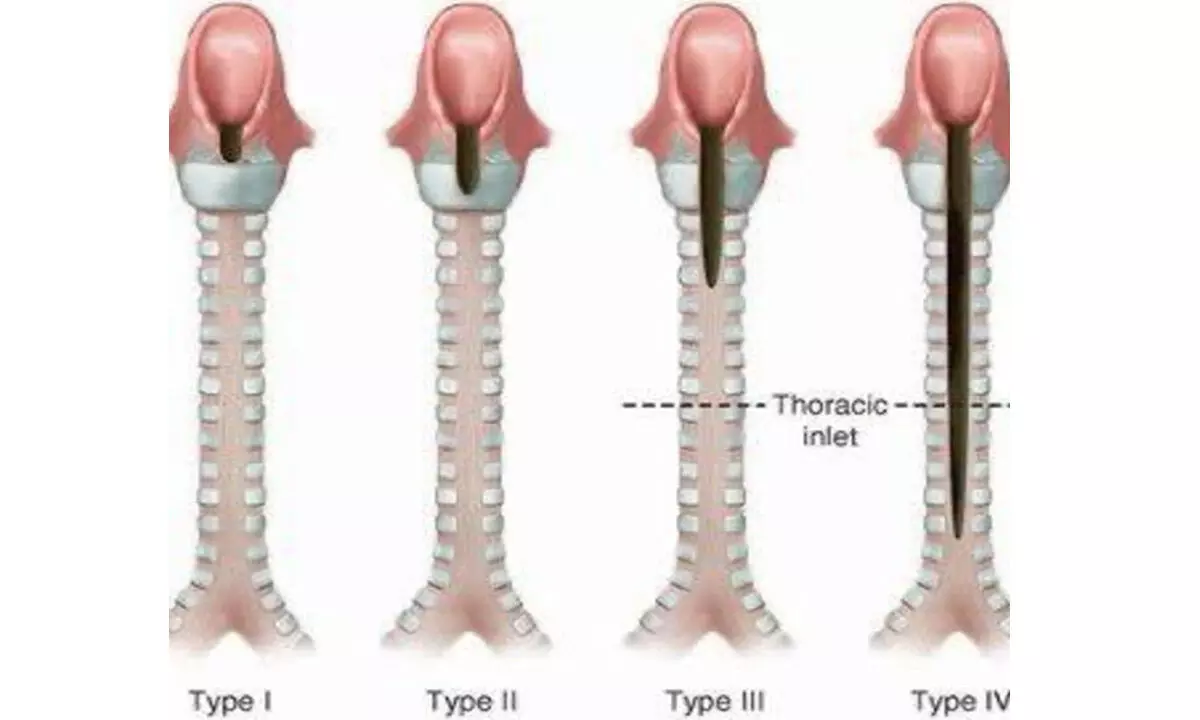Live
- Hero Motosports Team Rally Announces Squad For Dakar Rally 2025
- Two Men Found Dead In Parked Caravan In Kerala
- Mandhana moves closer to top spot in ODI, T20I rankings
- IND vs AUS Boxing Day Test 2024: Sam Konstas Debuts, Travis Head’s Fitness in Question
- Congress Challenges Election Rule Amendments In Supreme Court
- Jaishankar’s US Visit: Key Diplomatic Engagement Amid Leadership Transition
- Orthodox Church Bishop Criticizes PM Modi’s Christmas Celebration Participation
- Janhvi style & grace takes centre stage
- Allu Arjun’s Pushpa 2 Becomes First Hindi-Dubbed Film to Cross Rs 700 Crore
- ‘Legally Veer’ pre-release event creates buzz
Just In
Doctors successfully treat 1.2-yr-old infant with Type 1 laryngeal cleft


Type 1 laryngeal cleft is a rare medical condition with a low incidence of 1 in 10,000-20,000 births. While these clefts are not common, they severely affect the breathing and swallowing of children, in particular.
Bengaluru: Type 1 laryngeal cleft is a rare medical condition with a low incidence of 1 in 10,000-20,000 births. While these clefts are not common, they severely affect the breathing and swallowing of children, in particular.
A 1.2-year-old infant – weighing 8.5 kg – was experiencing challenges with feeding, and breathlessness, which led to respiratory difficulties and recurrent pneumonia since birth.
Baby was admitted to Sakra World Hospital in Bengaluru. A team of doctors, including Dr Honey Ashok, Senior Consultant in ENT, Head and Neck Surgery, Dr Anil Kumar P L, Senior Consultant and Head of Paediatric Surgery, and Dr Shishir Chandrashekhar, Senior Consultant and HOD - Anaesthesia and OT Management, teamed up for the treatment.
Dr Anil Kumar said, “The food pipe and the windpipe develop from a single tube during the foetal stage. A small percentage of children are born with connections between these tubes of varying severity called tracheo esophageal fistula and cleft. We suspected this problem when this child was presented to us with a cough while taking clear liquids. I am happy to share that through collaboration with the ENT team, we could diagnose the condition and treat it efficiently.”
Subsequently, the infant underwent a Bronchoscopic evaluation by Dr Anil Kumar. This examination confirmed a Type 1 laryngeal cleft. Given the baby’s age and health status, a minimally invasive treatment approach was chosen. “When a child’s larynx develops normally, it remains separate from the oesophagus, ensuring that swallowed food travels directly to the stomach without interference. However, a laryngeal cleft, also referred to as a laryngotracheal cleft, presents an unusual passage between the larynx and the oesophagus, allowing food and liquids to pass into the lungs.
The Type 1 condition leads to a range of challenges related to eating and breathing. In Type 1, the abnormal opening extends up to the level of lower cartilage of the voice box, situated above the vocal cords,” described Dr Ashok.
During the surgery, the anaesthesia management of the child was challenging due to the condition and because the child’s airway had to be ‘shared’ between the anaesthesiologist and the operating surgeon. “The presence of a specialised paediatric anaesthesia team at Sakra makes it possible for us to take on complex cases like this with good results,” lauded Dr.Chandrashekhar. Under general anaesthesia, “a filler containing baby’s own fat and hyaluronidase was injected into the gap. This procedure aimed to seal the connection between the larynx and the oesophagus, thus reducing the risk of aspiration and enhancing both breathing and feeding capabilities,” explained Dr Ashok, adding, “Great attention was paid to detail during the procedure to reduce the likelihood of complications post-surgery.”
After the procedure, the infant showed excellent recovery, with all symptoms completely resolved. Feeding issues disappeared and respiratory difficulties notably decreased. Follow-up examinations confirmed successful closure of the laryngeal cleft, with no signs of aspiration or pneumonia recurrence. The baby exhibited satisfactory growth and development, highlighting the effectiveness of the treatment.
“Identifying and treating laryngeal clefts early is crucial for the best results in infants. The outlook varies based on the type of cleft, with Roth et al. reporting mortality rates of 43 per cent for Types 1 and 2, 42 per cent for Type 3, and 93 per cent for Type 4,” elaborated Dr Ashok.
“We will forever cherish the incredible care and dedication shown by the team at Sakra World Hospital. Their unwavering support and expertise guided us through a challenging time, bringing hope and healing to our baby. We are overwhelmed with gratitude for their exceptional dedication and efforts,” thanked the
baby’s parent.

© 2024 Hyderabad Media House Limited/The Hans India. All rights reserved. Powered by hocalwire.com






